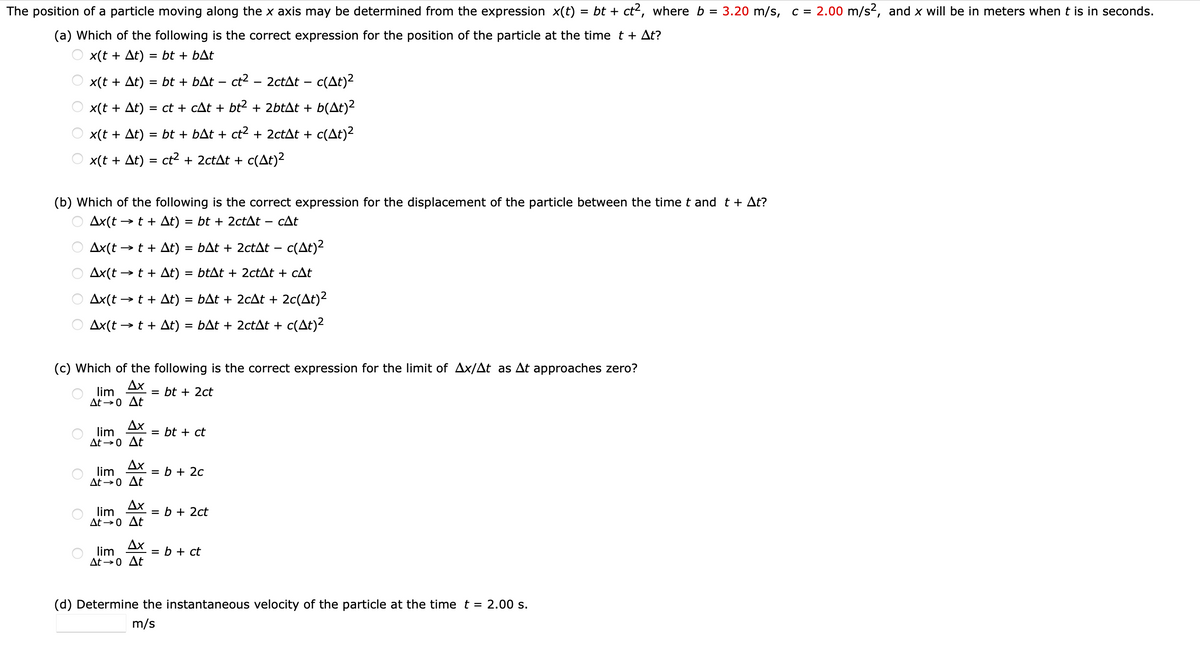The position of a particle moving along the x axis may be determined from the expression x(t) = bt + ct?, where b = 3.20 m/s, c = 2.00 m/s?, and x will be in meters when t is in seconds. (a) Which of the following is the correct expression for the position of the particle at the time t + At? x(t + At) = bt + bAt O x(t + At) = bt + bAt – ct² – 2ctat – c(At)? x(t + At) = ct + cAt + bt2 + 2btat + b(At)2 O x(t + At) = bt + bAt + ct2 + 2ctAt + c(At)2 x(t + At) = ct² + 2ctAt + c(At)? (b) Which of the following is the correct expression for the displacement of the particle between the time t and t+ At? Ax(t →t+ AAt) = bt + 2ctAt – cAt O Ax(t t+ At) = bat + 2ctAt - c(At)? Ax(t t + At) = btat + 2ctAt + cAt Ax(t t + At) = bAt + 2cAt + 2c(At)? O Ax(t -t + At) = bAt + 2ctAt + C(At)? (c) Which of the following is the correct expression for the limit of Ax/At as At approaches zero? Ax = bt + 2ct lim At-0 At lim AX = bt + ct At0 At Дх = b + 2c lim At -0 At Ax = b + 2ct lim At-0 At Дх = b + ct lim At-0 At (d) Determine the instantaneous velocity of the particle at the time t = 2.00 s. m/s
The position of a particle moving along the x axis may be determined from the expression x(t) = bt + ct?, where b = 3.20 m/s, c = 2.00 m/s?, and x will be in meters when t is in seconds. (a) Which of the following is the correct expression for the position of the particle at the time t + At? x(t + At) = bt + bAt O x(t + At) = bt + bAt – ct² – 2ctat – c(At)? x(t + At) = ct + cAt + bt2 + 2btat + b(At)2 O x(t + At) = bt + bAt + ct2 + 2ctAt + c(At)2 x(t + At) = ct² + 2ctAt + c(At)? (b) Which of the following is the correct expression for the displacement of the particle between the time t and t+ At? Ax(t →t+ AAt) = bt + 2ctAt – cAt O Ax(t t+ At) = bat + 2ctAt - c(At)? Ax(t t + At) = btat + 2ctAt + cAt Ax(t t + At) = bAt + 2cAt + 2c(At)? O Ax(t -t + At) = bAt + 2ctAt + C(At)? (c) Which of the following is the correct expression for the limit of Ax/At as At approaches zero? Ax = bt + 2ct lim At-0 At lim AX = bt + ct At0 At Дх = b + 2c lim At -0 At Ax = b + 2ct lim At-0 At Дх = b + ct lim At-0 At (d) Determine the instantaneous velocity of the particle at the time t = 2.00 s. m/s
Principles of Physics: A Calculus-Based Text
5th Edition
ISBN:9781133104261
Author:Raymond A. Serway, John W. Jewett
Publisher:Raymond A. Serway, John W. Jewett
Chapter2: Motion In One Dimension
Section: Chapter Questions
Problem 6P: The position of a particle moving along the x axis varies in time according to the expression x =...
Related questions
Concept explainers
Topic Video
Question

Transcribed Image Text:The position of a particle moving along the x axis may be determined from the expression x(t) = bt + ct2, where b
3.20 m/s, c = 2.00 m/s?, and x will be in meters when t is in seconds.
(a) Which of the following is the correct expression for the position of the particle at the time t + At?
x(t + At) = bt + bAt
X(t + Δt)
= bt + bAt
ct2 – 2ctAt – c(At)2
|
x(t + Δt)
= ct + cAt + bt? + 2btAt + b(At)?
x(t + Δt)
= bt + bAt + ct2 + 2ctAt + c(At)2
x(t + Δt)
ct2 + 2ctAt + c(At)²
(b) Which of the following is the correct expression for the displacement of the particle between the time t and t + At?
Ax(t -
→ t + At) = bt + 2ctAt
cAt
Ax(t → t + At) = bAt + 2ctAt – c(At)?
-
O Ax(t →t + At) = btAt + 2ctAt + cAt
Ax(t → t + At) = bAt + 2cAt + 2c(At)2
Ax(t →t + At) = bAt + 2ctAt + c(At)²
(c) Which of the following is the correct expression for the limit of Ax/At as At approaches zero?
Ax
lim
= bt + 2ct
At →0 At
Ax
= bt + ct
lim
At →0 At
Ax
b + 2c
lim
At →0 At
Ax
= b + 2ct
lim
At →0 At
Дх
= b + ct
lim
At →0 At
(d) Determine the instantaneous velocity of the particle at the time t = 2.00 s.
m/s
O O O O O
Expert Solution
Step 1
Given data
The position of the particle is x (t) = bt + ct2
The constant b = 3.20 m/s
The constant c = 2 m/s2
Trending now
This is a popular solution!
Step by step
Solved in 3 steps

Knowledge Booster
Learn more about
Need a deep-dive on the concept behind this application? Look no further. Learn more about this topic, physics and related others by exploring similar questions and additional content below.Recommended textbooks for you

Principles of Physics: A Calculus-Based Text
Physics
ISBN:
9781133104261
Author:
Raymond A. Serway, John W. Jewett
Publisher:
Cengage Learning

Principles of Physics: A Calculus-Based Text
Physics
ISBN:
9781133104261
Author:
Raymond A. Serway, John W. Jewett
Publisher:
Cengage Learning